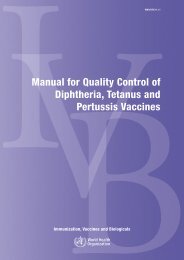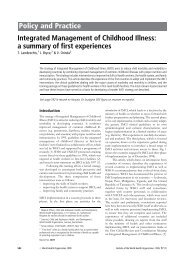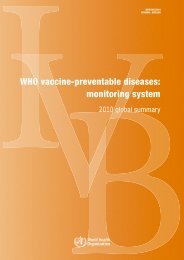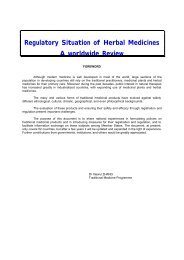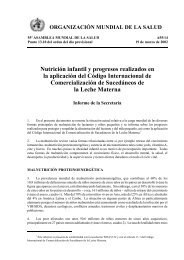IPDE - Extranet Systems - World Health Organization
IPDE - Extranet Systems - World Health Organization
IPDE - Extranet Systems - World Health Organization
You also want an ePaper? Increase the reach of your titles
YUMPU automatically turns print PDFs into web optimized ePapers that Google loves.
37 Epidemiology of DSM-Ill PDs<br />
might be used to establish conshuct validity. Biological markers will also<br />
be important in future research as another source of external validation.<br />
Another method of validation is to determine whether the course or<br />
natural history of PDs justifies their differentiation. Few such studies<br />
have been done, because of the time and wst of prospective designs. hut<br />
longitudinal studies can pmvide information not available from crosssectional<br />
ones. They could identify predictors of future PDs, modifying<br />
variables, and medical and social service needs. They also offer an<br />
opportunity to examine the effect of temperament as an important predisposing<br />
variable. Another issue that wuld be explored in this way is<br />
the temporal stability of PDs. Although as defined in the ICD-l0 and<br />
DSM-111, PDs are long-lasting disorders, very limited data are available<br />
regarding this. For this reason it would be worth investigating the epidemiology<br />
of PDs in different age groups, as an indication of the course<br />
of PDs. Longitudinal studies will also provide evidence for the validity<br />
of the concept of PD as constant maladaptive behaviour across time and<br />
environmental circumstances."<br />
Finally, treatment response is also a validator. Although PDs are considered<br />
stable and long lasting, it is possible that effective treatments will<br />
ultimately be developed, as with other psychiatric disorders, and treatment<br />
response could also be used to validate the different types of PD.<br />
There has been a remarkable advance in our understanding of the epidemiology<br />
of PDs in the last few years. As this continues, we should better<br />
understand not only the PDs, but also other mental disorders.<br />
References<br />
l Casey, P.R Epidemiology of personality disorders. In Tyrer, P. (ed.) Personalily<br />
Disorders: Diagnosis. Management andcourse. London: Wrighf 1988.<br />
2 Metikangas, K.R. & Weissman, M.M. Epidemiology of DSM-111 Axis 11 personality<br />
disorders. In: Frances, A.J. & Hales, R.E. (eds), APA Annual Review, vol. 5.<br />
Psychiarry Update, pp. 258-78. Washington, DC: American Psychiauic Press.<br />
1986.<br />
3 Merikangas. K.R. Epidemiology of DSM-111 personality disorders. In Michels,<br />
R. er al., (eds.). Psychiatry, v01 3, pp 1-16. Philadelphia: Lippincott, 1989.<br />
4 Weissman, M.M. The epidemiology of personality disorders: A 1990 update.<br />
Journal ofPersonalily Disorders. 1993; 7.4462.<br />
5 Andrwli, A., Glessot, G., Aapro. N., Tricot, L. & Gognalons, M.Y. Personality<br />
disorders as a predictor of outcome. Joumal of Personality Disorders, 1989; 3:<br />
307-20.<br />
6 Reich. J.H. & Green, A.I. Effect of personality disorders on outcome of treatment.<br />
Joumal ofNewousandMenralDisease. 1991; 179: 74-82.




